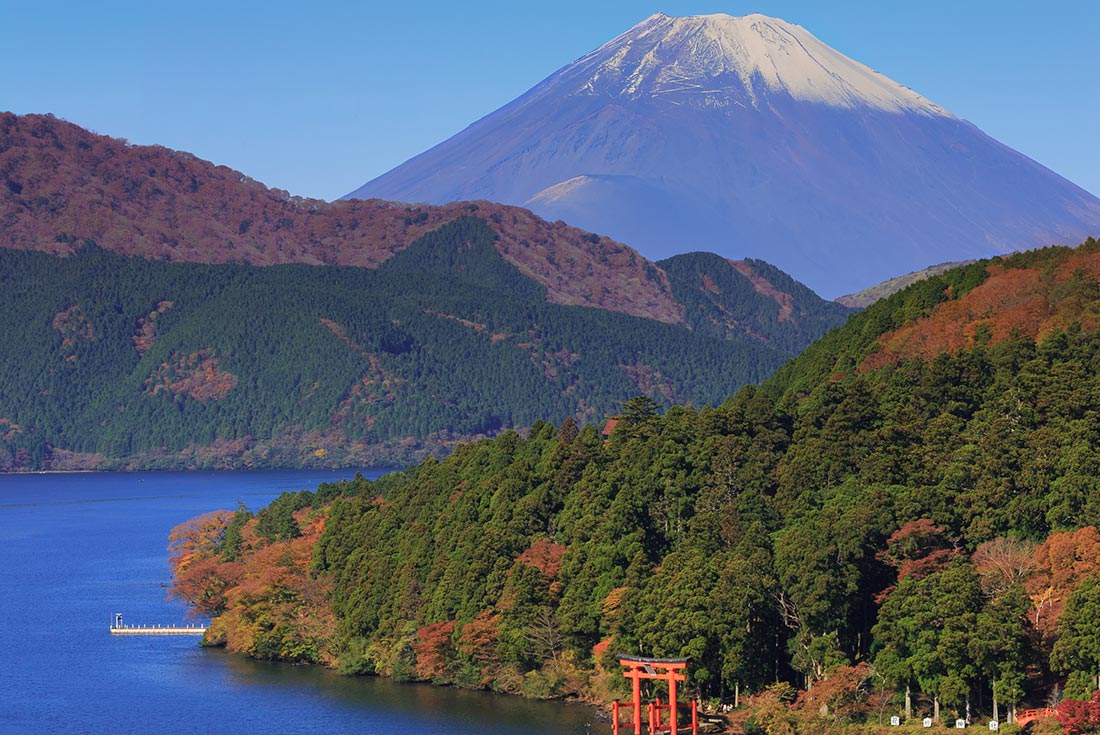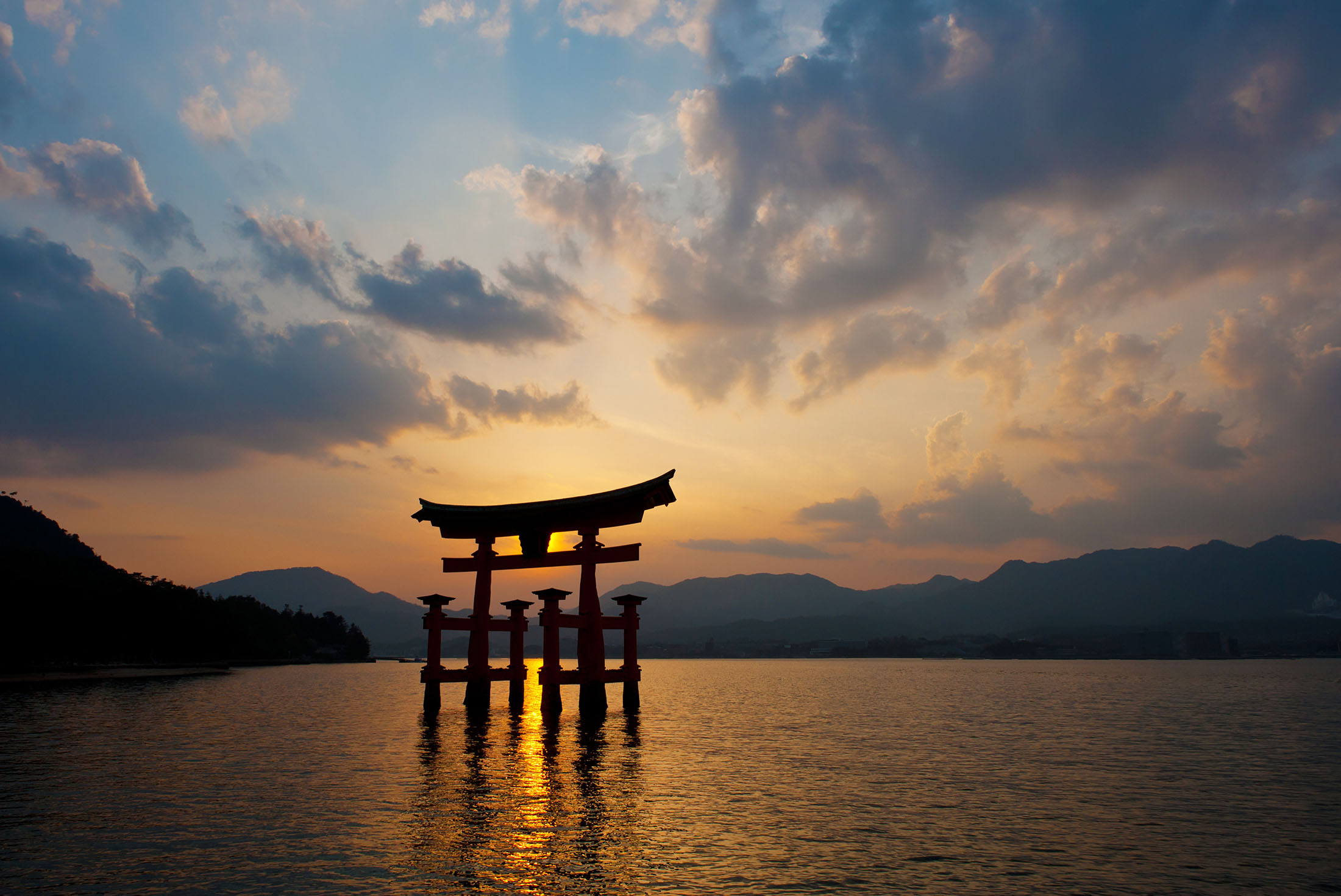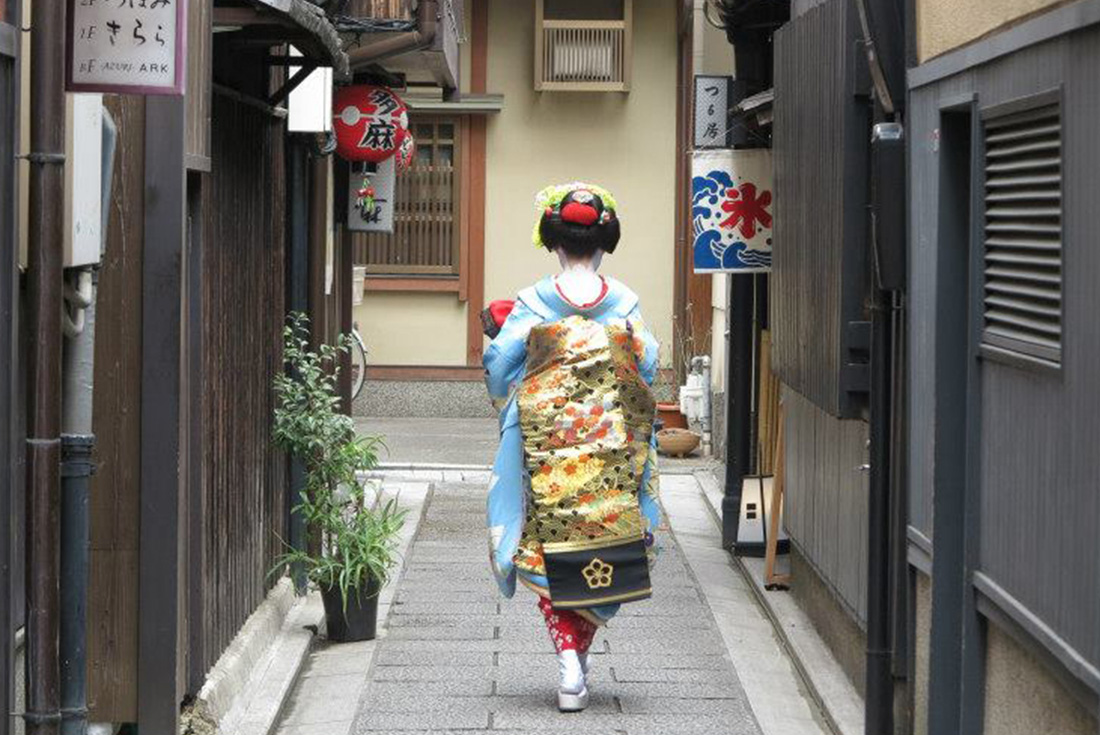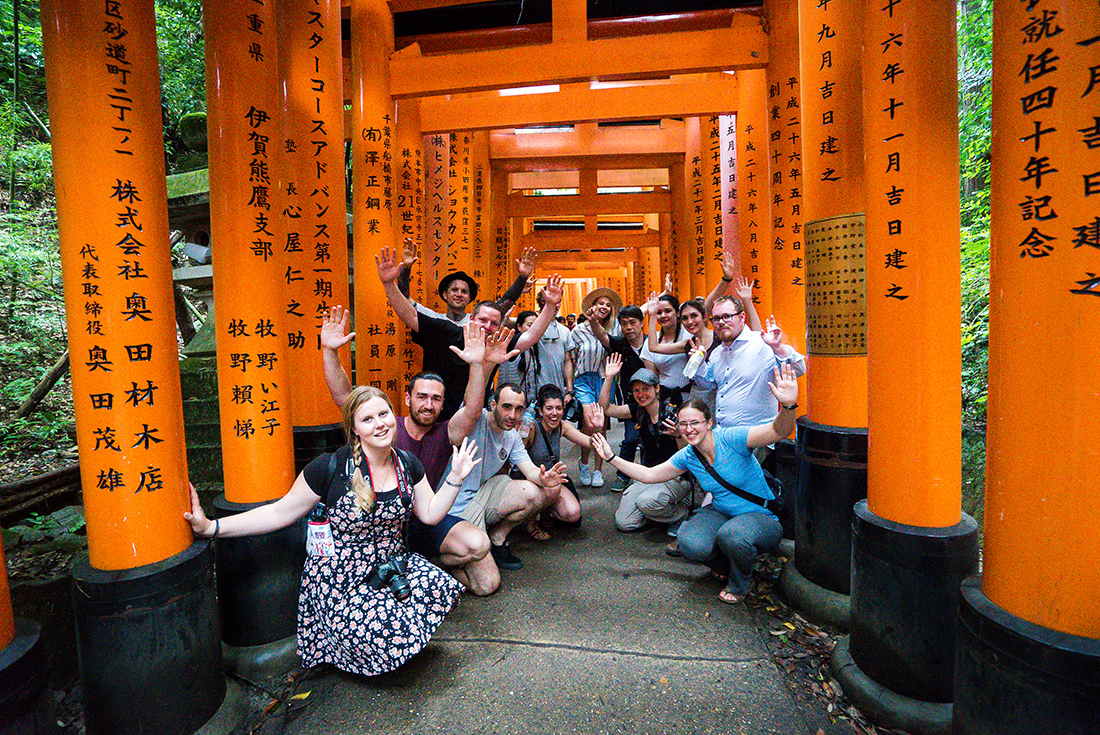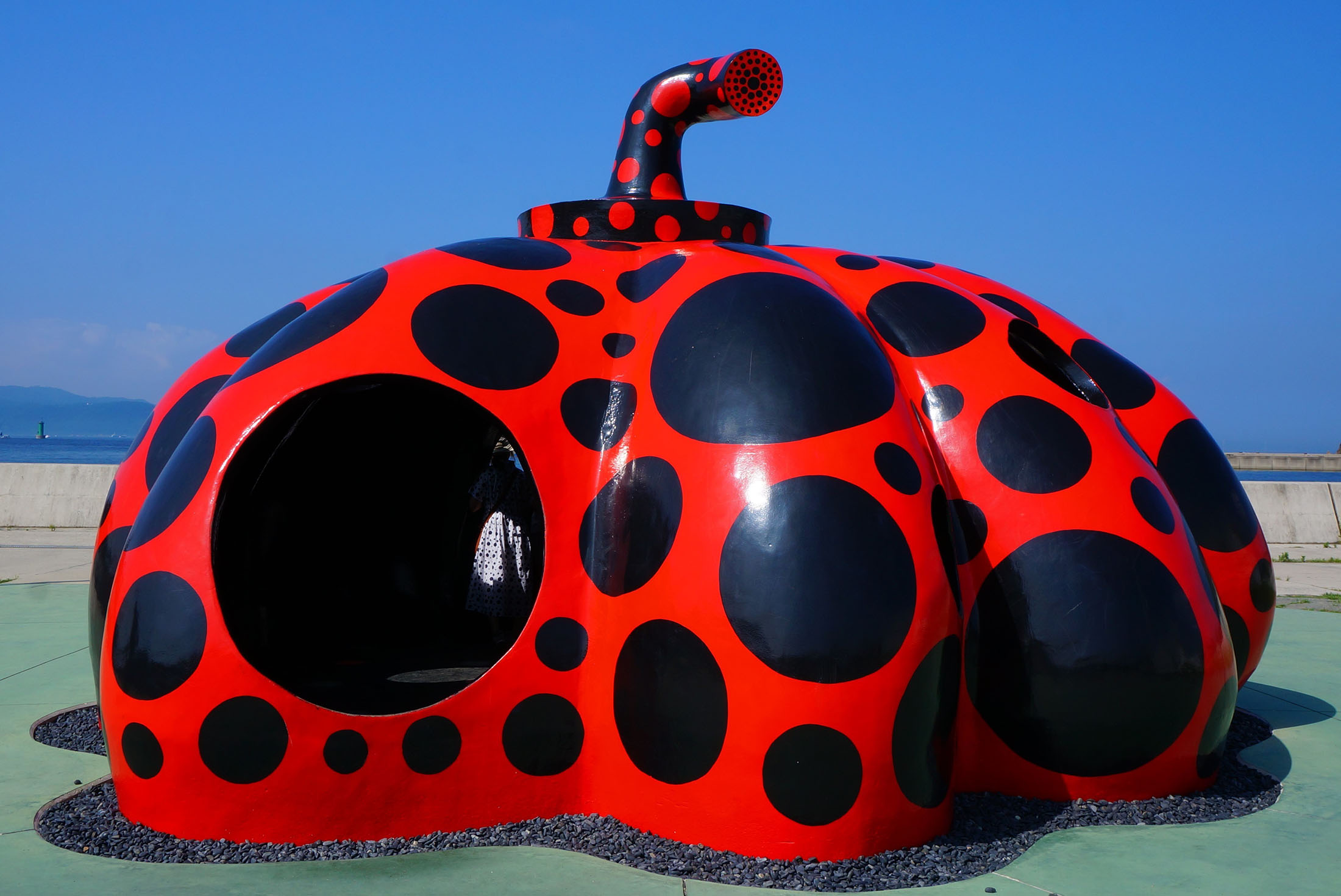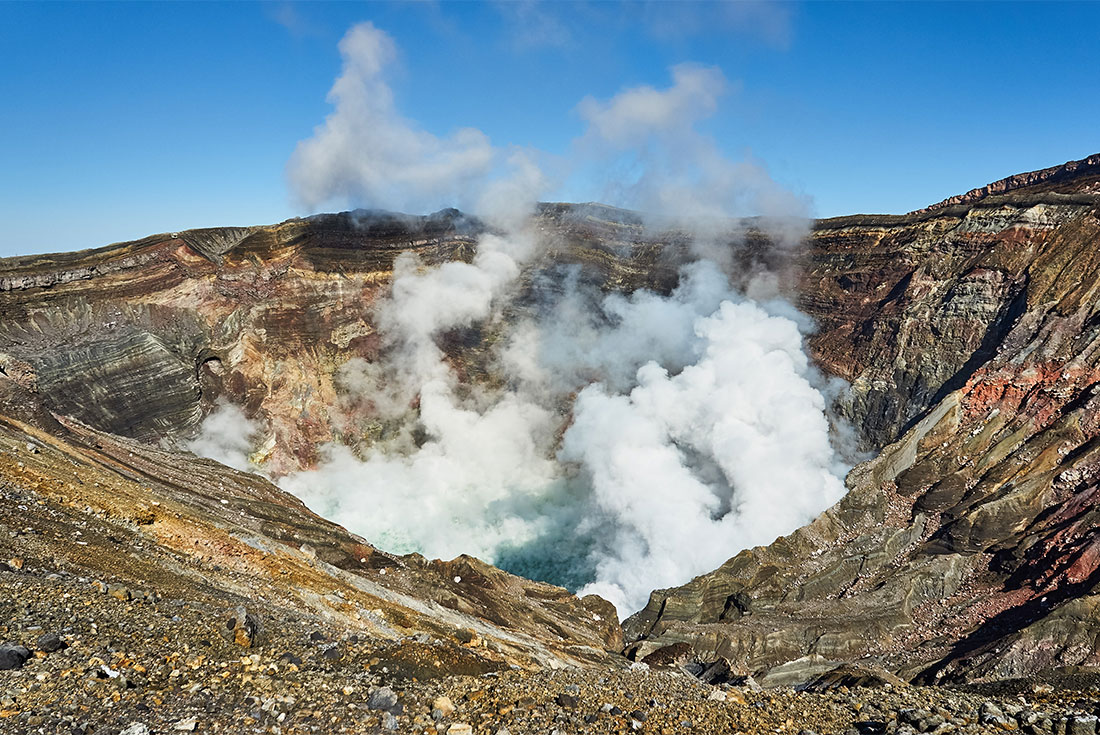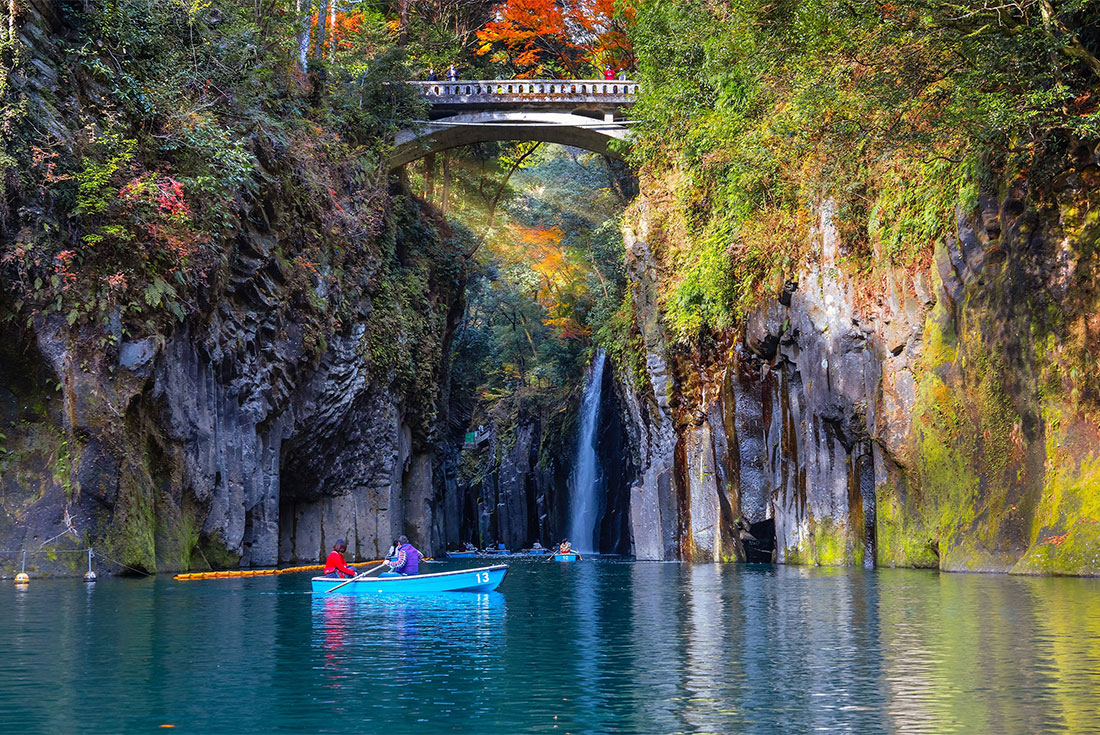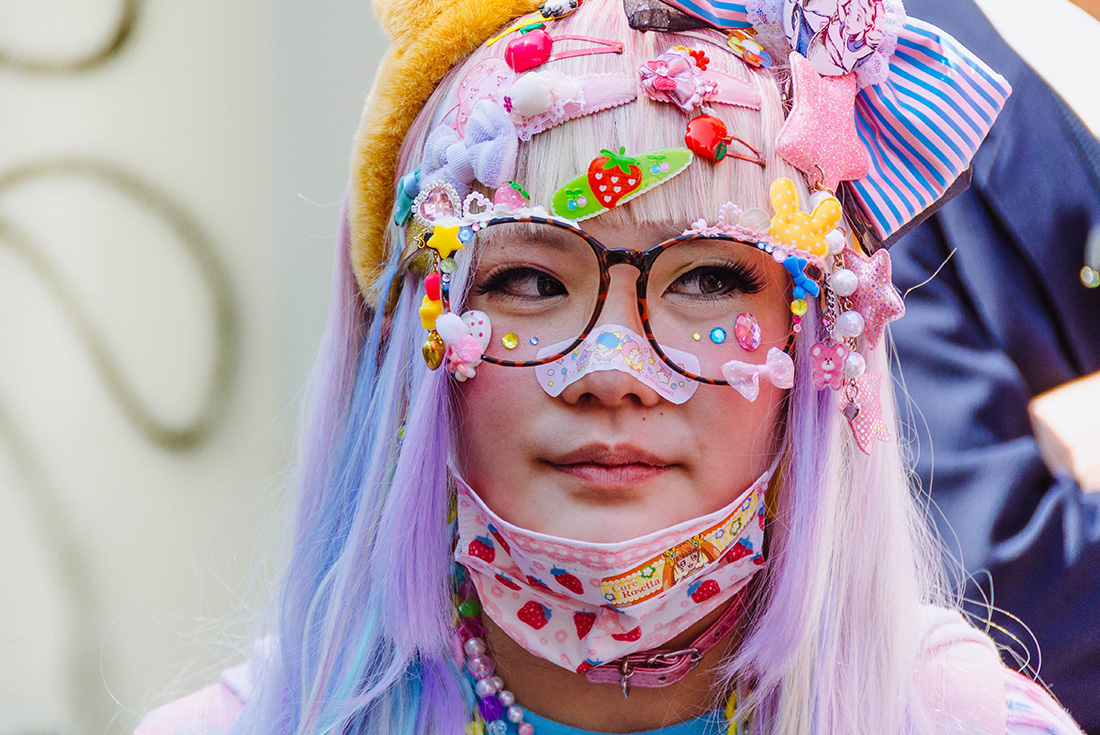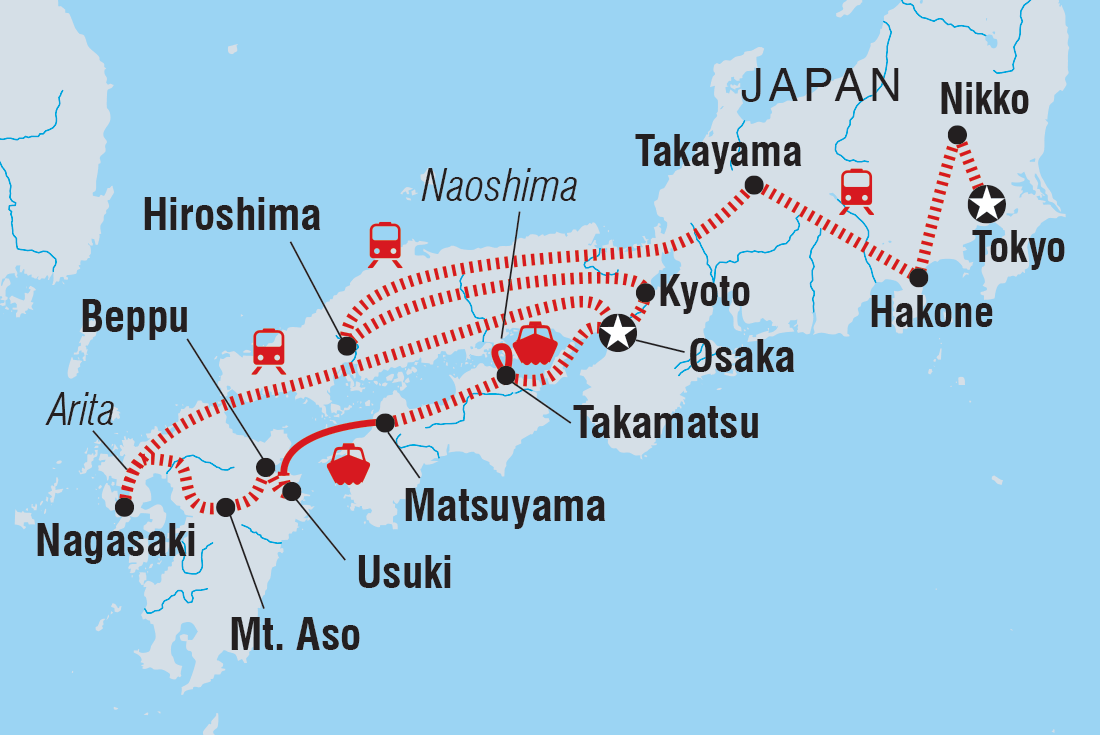SUMMARY
Begin your Japanese adventure in the tech-mecca of Tokyo, then discover scenic beauty on the Hakone ropeway, sip the best sake in Takayama and be reminded of the sobering past of Hiroshima. Visit the floating torii gate of Miyajima and make use of your local leader and guides to reveal layers of culture and history in lesser-known cities. Spend some time in Kyoto and then veer off the main island of Honshu to the naturally beautiful southwest. Wander through art-laden castles, spend a night in a tranquil homestay in Usuki and relax in the steam of Beppu’s onsens. Soak up the peace in the caldera of Mt Aso in a traditional Japanese inn surrounded by rice terraces. Visit the Peace Park in Nagasaki and end it all back in Osaka. This adventure is the ultimate combination of new and ancient, countryside villages and dynamic city streets, traditional inns and onsens, and sweeping views of coastal cities, rice terraces, volcano craters and deep gorges. When visiting Japan, what more could you ask for?
TOTAL DURATION : 24 Days
GROUP SIZE : MIN 1 MAX 12
TOUR ITINERARY AND DATES
START : Tokyo
END : Osaka
COUNTRIES VISITED : Japan
Validity : 01 JAN 2024 To 31 DEC 2024
Day :1
Location : Tokyo
Konnichiwa! Welcome to Japan. Bursting with contemporary urban culture, there are many sides of Tokyo to explore, from fascinating museums and world-class shopping, to neighbourhood backstreets lined with hole in the wall eateries and bars. Your adventure begins with a welcome meeting at 6 pm tonight. You can arrive at any time during the day, as there are no activities planned until this important meeting. Afterwards, join your new travel companions for an optional dinner at a local restaurant.
Day :2
Location : Tokyo - Nikko
Catch the shinkansen bullet train today (approximately 1 hour) and then a local train (approximately 1 hour) to get from Tokyo to Nikko. Japanese trains are a quintessential experience and one of the best insights into culture (and efficiency!) of the country. Enjoy shopping for snacks or bento box at the train station or simple snacks are available for purchasing on board too. Arrive in Nikko late afternoon and you'll stay in a small inn tonight with shared facilities.
Day :3
Location : Nikko
You have a full day to explore Nikko today, an ancient town overflowing with beautiful shrines and temples. A number of shrines here are World Heritage Sites and the town is surrounded with lush mountainous nature. You'll visit Toshugu Shrine, a resting place of a Tokugawa shogun who was one of the most powerful rulers of the country. The opulent shrine contrasts with the traditional minimalist style commonly used throughout Japan. Every corner of this monument is covered in intricate gold leaf, lacquer work, paintings and patterns. Here you can also visit the Nikko Toshogu Museum of Art at the back of the temple complex (extra entrance fee apply). This 1920s mansion has a beautiful collections of sliding doors and screens decorated by the best Japanese painters of the day. In your free time, you can pay a visit to the red-lacquered Shin-kyō bridge, one of the town’s most famous landmarks, and the Buddhist temple of Rinnō-ji, home to fearsome statues and an elegant garden. Or you may prefer time exploring Nikko’s beautiful natural setting with a visit to Chuzenji Lake and Kegon Falls. Kanmangafuchi Abyss is another highlight in Nikko that your leader will take you to visit, where you'll see about 70 Jizo Buddhas looking out to the river.
Day :4
Location : Hakone
Leaving Nikko, you'll have a long travel day today to our next destination - Hakone. Travel by local train followed by two shikansen bullet trains and finally a bus. Phew! Total travel time can vary depending on the connections, but we will usually arrive by mid afternoon.The journey is certainly worth it as Hakone is a scenic hot-springs resort in the foothills of Mt Fuji. You’ll be staying at a family run ryokan tonight, with tatami-mat rooms, shared bathroom facilities and a lovely outdoor hot-spring onsen.
Day :5
Location : Hakone
This morning, hop on a boat across Ashinoko Lake and then tride the Hakone ropeway cable car to the top of the surrounding mountains. The area around the lake offers plenty of stunning views, and you may even catch a glimpse of Mt Fuji in the distance if weather conditions are clear. The afternoon is free to further explore Hakone’s spectacular mountain scenery and volcanic sites. Perhaps visit the boiling sulphur springs of Owakudani, or Hakone Jinja Shrine with its red torii gate rising from the shore of Ashinoko Lake. Or go for a walk through the hills of the famed grassland ecosystem of Sengokuhara. There’s also a great collection of art at the Hakone Open-Air Museum and the Pola Museum of Art, an eclectic mix that includes work by the likes of Renoir, Monet, Picasso, Van Gogh, Cézanne and Gallé. Not what you would expect to find in a small Japanese town, right?
Day :6
Location : Takayama
Travel by a local train first then a shikansen towards Takayama in alpine Gifu Prefecture today. You’ll reach speeds of 270 kilometres per hour and it will take around 4 hours to get there in total. Takayama is a charming Edo period town located in the Japanese alps, famous for its traditional inns, sake breweries and the Hida Folk Village. The latter is your first stop, an outdoor museum where the traditional thatched-roof architecture unique to the area has been relocated in a delightful mountain setting in an effort to preserve traditional Japanese culture. Discover the techniques used to build farmhouses that could withstand fierce winters and long periods of isolation due to snow-closed roads. The thick thatching kept in warmth and the roofs were angled so as to minimise snow build-up. Each house is like its own self-contained museum, with displays of personal items and traditional tools. Your included dinner tonight will give you the chance to taste some of Takayama’s famous signature dishes.
Day :7
Location : Takayama
Enjoy a typical local breakfast this morning at the ryokan before our visit to the morning market. Gifu prefecture is known to produce many fine high-altitude vegetables, and these markets have been held for over 600 years. Browse the stalls of seasonal vegetables brought in from the surrounding countryside, set up by local farm women from 6am every morning. Look out for the unique local style of pickles, the bags of miso wrapped in leaves, Genkotsu ame (soy bean candy), preserved fish, spices, and the delicious marshmallow treat of owara tamaten. The alpine climate and crystal clear mountain waters are perfect for creating sake, so you'll also visit a local brewery for a taste of the region's prized signature drop later today. The rest of the day is free for you to explore this delightful little town.Takayama is also very famous for Hida beef. Don't miss the opportunity to try some of the country’s best while you're in town for lunch or today.
Day :8
Location : Hiroshima
Time to leave Takayama and travel by express train and shinkansen (approximately 5 hours) to Hiroshima. Depending on arrival times, we will either visit Hiroshima’s Peace Park this afternoon or tomorrow morning. The Genbaku (A-Bomb) Dome and Peace Memorial Museum stand testament to the fateful day in August 1945 when Hiroshima was chosen as target for the first ever wartime use of the atomic bomb. The dome was just metres from where the bomb detonated so it was able to retain its shape and the fact that it looks almost exactly as it did after the bombing has made it an enduring symbol of peace. The memorial park serves the same purpose, and has museums, memorials and monuments dedicated to the memory of victims. This evening, maybe try one of the city’s signature dishes for dinner – okonomiyaki, a savoury pancake of egg, cabbage, soba noodles, and meat or seafood. Our accommodation tonight will either be a simple ryokan or hotel.
Day :9
Location : Miyajima - Hiroshima
Today you'll make your way to the nearby island of Miyajima with its famous 'floating' torii gate. You might like to further explore the island by climbing to the top of Mt Miyajima (or hopping on the cable car instead) for 360-degree views of the Inland Sea. Keep your eyes out for inquisitive and hungry deer that roam the streets. You have the rest of the day free to enjoy some of the other sites in this very welcoming and pleasant city. You could stop by the magnificent five-storied Hiroshima Castle, which originally dates from the 1590s. It was destroyed by the bomb but reconstructed in all its glory in the 1950s, and now holds an informative museum. The wonderful Shukkeien Garden, with its graceful teahouses and waterfalls, is also a perfect place to decompress on a break from sightseeing. For something a bit louder, there are local baseball and soccer teams (if the day is right), or endless shopping choices. Ask your leader for other tips and suggestions as there is plenty to see and do.
Day :10
Location : Kyoto
Leave Hiroshima today and head to Japan’s most impressive samurai castle at Himeji by shinkansen (approximately 1 hour). The building, which has survived earthquakes and war since the mid-16th century, was restored to its full glory in 2015. The moats, baileys, towers and walled alleyways were ingeniously designed to trick attackers – perhaps so intimidatingly that they were never in fact tested. Explore the castle that was once home to over 10,000 samurai families and look out over the castle grounds and the city below from the seventh floor. Hop back on the shinkansen for the 1 hour train trip to Kyoto. Originally founded as Heian-kyo (literally “tranquillity and peace capital”) by Emperor Kammu in 794, Kyoto had its golden age during the imperial court's heyday from 794 to 1185. Kyoto was the capital of Japan for over 1,000 years (the name means “Capital City”) but the emperor and government are now located in Tokyo. With over 2,000 temples, shrines and gardens, Kyoto is a great place to get lost in. Your leader will take you on an orientation walk on arrival to get your bearings and you may like to spend some further time getting acquainted with Kyoto by wandering through its historical streets lined with traditional machiya houses. Stay in a ryokan or simple hotel during our time here.
Day :11-12
Location : Kyoto
With its many cultural landmarks and historical sites, and the abundance of traditional arts and literature, Kyoto is regarded as the cultural heart of Japan. Your tour leader will take you to visit two of the best temples this morning. Afterwards, it's your free time to explore this charming ancient capital. You will have almost one and half free days here to exploreand there is a lot to see and experience here. Your tour leader will be able to help you with making the most out of your time. Fushimi Inari is definitely one of the most photographed shrines in Japan. For the more active, hiking up the mountain following the red torri gates is a great way to enjoy the expansive forest on the shrine’s grounds and views of the city below. Otherwise, maybe head off to Arashiyama to enjoy a wander through the Sagano bamboo forest, or cycle along the Kamo River. Another great stop is the architecturally impressive Higashi Honganji Temple and the almost surreal Sanjusangendo, home to 1,001 statues of Kannon, or the Nishiki food market. A gentle stroll through Kyoto's eastern hills along the ‘Path of Philosophy’ that links Ginkaku-ji, the Temple of the Silver Pavilion, with Nanzen-ji Temple is also recommended. This walk can be extended south through the well-preserved ‘old town’ areas to Kiyamizu-dera (Temple of Clear Water) with its famous viewing platform. Also recommended, for those visiting in spring, is a visit to the theatre for a presentation of Miyako Odori (Cherry Blossom Dance) performed by elaborately dressed maiko (apprentice geisha), or a visit to the extravagantly decorated Kinkakuji Temple, immortalised in Yukio Mishima’s novel “The Golden Pavilion”. On one of the evenings, your leader will take you on a stroll through Gion, Kyoto's famous Geisha district. Even today you can observe the age-old tradition of geisha as they head out to perform dances and song for members of the wealthy elite in small teahouses tucked away in tiny back streets.
Day :13
Location : Osaka
This morning, say goodbye to the members of your group who are leaving and hop on a train to Osaka – the ever-vibrant unofficial culinary capital, whose motto is 'Kuidaore' (eat until you drop). When you arrive, you’ll have free time to wander the trendy streets or pick up some lunch, before another welcome meeting at 6 pm tonight. After, perhaps join your new travel companions for an optional dinner at a local restaurant.
Day :14
Location : Takamatsu
Depart Osaka this morning and begin the journey west. Take the train across the bridge spanning the stunning Inland Sea and onto Takamatsu. This may be the largest city on the island of Shikoku (the smallest of Japan’s four main islands), but it's a beautifully unpretentious town full of history, top-notch food and interesting local art. Here, you'll visit Ritsurin Garden – one of the most beautiful gardens in the country. Dating back to the Edo period, it comprises several ponds and arched bridges designed around strolling paths, tea pavilions and historic trees, with a western garden in addition to the Japanese one. The garden also houses the Sanuki Folkcraft Museum, which displays a variety of ceramics and basketwork dating from the time of the Tokugawa shoguns.
Day :15
Location : Naoshima Island/Takamatsu
Take the ferry this morning for a daytrip to the island of Naoshima, in the Inland Sea between Takamatsu and the mainland – famous worldwide for its modern art galleries, museums, avant-garde architecture and lovely natural setting. Explore the island by public bus or bicycle to take you between the galleries and installations. Wander between artworks, hear the sound of waves lapping at quiet coves and stumble upon the wonderful outdoor sculptures. Return to Takayama after a full day on the island, where you’ll have a free night.
Day :16
Location : Matsuyama
This morning, take the train and head west to Matsuyama – one of Japan’s least discovered prefectures coined ‘the citrus state’ by the locals. When you arrive and have maybe picked up a mikan (mandarin) or two, visit the hill-top Matsuyama Castle with your group. This is one of Japan's most impressive surviving castles, sitting right in the middle of the city. Unlike most castles in Japan, this one has an exciting collection of artefacts inside, so take the chance to check them out and learn a little more about Matsuyama's feudal history while you’re there. This afternoon, you’ll have some free time to relax and unwind at the Dogo Onsen – one of the oldest bath houses in Japan – or if you’d prefer more exploration, maybe visit Ishiteji Temple – the 51st of the 88 temples that make up Shikoku’s 88 Sacred Temples circuit (Japan’s most famous pilgrimage route).
Day :17
Location : Usuki Homestay
Get ready for a bit of a travel day today. Jump on a train and then ferry for Usuki, on Kyushu Island – the third largest of Japan’s four main islands. When you arrive around midday and get on a public bus to the village. You’ll visit the local sake brewery, where you’ll get to see how sake (the national drink of Japan, beloved by the locals) is made, followed by a tasting of the brewery’s finest. Your hospitable hosts will be waiting for you as well and will welcome you into their house once you arrive. Your evening here will be filled with fun, collaborative dinner preparation, followed by a feast of delicious home-cooked dishes. Share stories with your hosts, get to know about their life here and learn a few things about Japanese cooking that you can bring home with you.
Day :18
Location : Beppu
Say goodbye to your hosts after a traditional home-cooked breakfast together. Then, head to Beppu, famous for its variety of hot springs and onsens in Kyushu. When you arrive, you’ll visit Jigoku (translated to 'hell' & you'll see why locals call it that) – a collection of differently coloured steaming hot spring pools that showcase different benefits. After, head to a local Michelin star onsen for an authentic onsen experience including a relaxing soak. After the soak, a special steamed dinner awaits! This specialty restaurant offers a unique dining experience where you can select the food you’d like, put the dishes in a steamer and watch as they’re cooked by the steam of the hot springs! This means your food will be infused with all the healthy minerals of the baths. Some may find this a little bland as very limited seasoning is used however this is the perfect chance to enjoy the true original flavors of the food.
Day :19
Location : Mount Aso
Today is all about chasing stunning views! Hop in your private transfer this morning and head to Mt Aso, stopping at Ogi Rice Terrace along the way. Soak up the scenic landscape of Ogi, which locate between Mt. Aso and Kuju Mountains Range. When you’ve snapped some photos, head on to the Daikanbo Observatory for some pretty excellent views of the five central peaks of Mt Aso. This viewpoint is also known as the Nehan-zo, or Nirvana Buddha, referencing the image of Buddha in repose. Fuel up your energy with a lunch stop and then get ready for a hike on the moon-like Sunesenri trail to Nakadake Crater – the largest among the five craters of the mountain. After your hike, continue your journey to your accommodation for the next two nights – you’ll be staying in a traditional Japanese inn, right in the caldera formed from ancient volcano eruptions. Surrounded by rice fields, you’re in for a peaceful couple of days and nights here.
Day :20
Location : Mount Aso
This morning after breakfast, you’ll head out and visit the stunning Takachiho Gorge – a narrow chasm cut through the rock by the Gokase River. This gorgeous spot has sheer cliffs of volcanic basalt columns, which the locals say represent the scales of a dragon. Here, you’ll hop in rowing boats and head out on a serene paddle through the gorge, passing Minainotaki Waterfall against the backdrop of the green foliage (this area is especially colourful in autumn!). After, take a walk above the gorge for a different perspective, followed by a visit to Takachiho Shrine. Return to your guesthouse in the mid-afternoon.
Day :21
Location : Arita/Nagasaki
This morning, say goodbye to your scenic guesthouse and hop back on the train to the porcelain town of Arita – porcelain in Japan was first produced here and this small town is known nationwide for its pottery, known as Arita-yaki. Embark on a walking tour to see the old part of town and the Tonbai Wall Alleys. Then, continue to Tozen Shrine, dedicated to the god of pottery – you’ll see the locals’ dedication to the art form here, as they even have a porcelain Torii gate and a porcelain guardian dog! Continue to Nagasaki via train, arriving in the late afternoon. You have a free evening, so maybe ask your leader where to grab the best local fare.
Day :22
Location : Nagasaki
Wake up in Nagasaki this morning – the coastal city set on a natural harbour, with the surrounding hills providing gorgeous viewpoints over the scenic hub. Visit the Peace Park and Atomic Bomb Museum for a sobering reminder of what happened on that dreadful day – the 9th of August 1945. If you wish to reflect and explore further, there are some other interesting museums nearby worth visiting. Take the time to explore Nagasaki in your free afternoon. Consider heading over to Dejima – this fascinating artificial island was once a Dutch trading post in the 17th to the 19th centuries (and the sole foreign presence in the whole country at one point). The 26 Martyrs Memorial, Oura Catholic Church, Glover Garden and Dutch Slopes also give you a glimpse into the life of the early Christians and European traders in Japan. This evening, maybe slurp up some champon noodles (ramen, Nagasaki-style)!
Day :23
Location : Osaka
Say goodbye to Kyushu and jump on the shinkansen back to Osaka. When you arrive this afternoon, soak up some free time to relax or explore. Tonight, why not head out for dinner and drinks with your leader and fellow travellers, to celebrate an amazing trip in southern Japan?
Day :24
Location : Osaka
With no further activities planned, your trip comes to an end this morning. That doesn’t mean your time in Japan has to end! There is plenty to do and explore in Osaka, so if you’d like to extend your stay, just speak to your booking agent ahead of time.
Reference : IT

